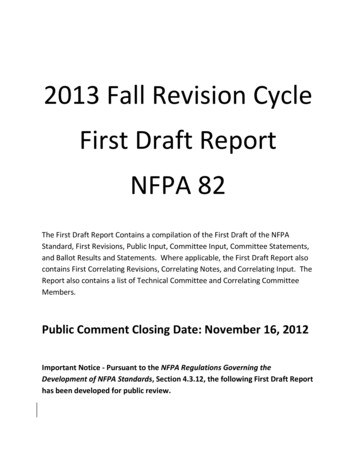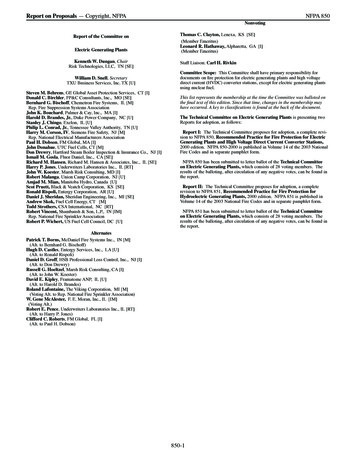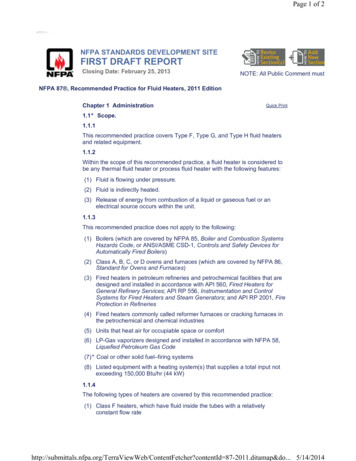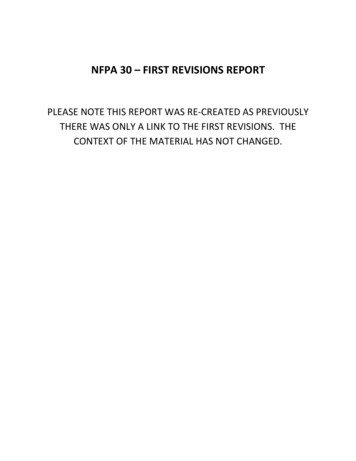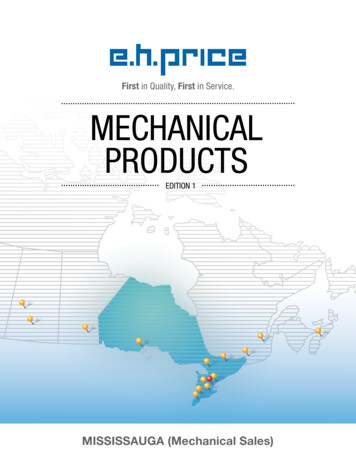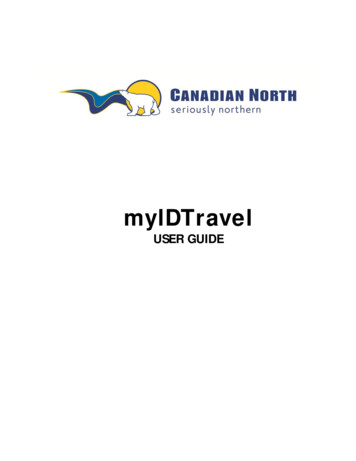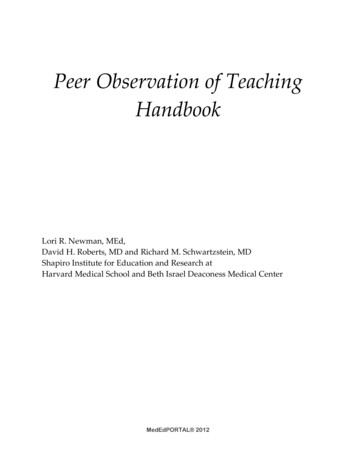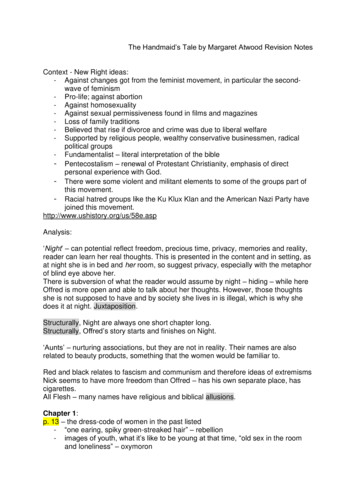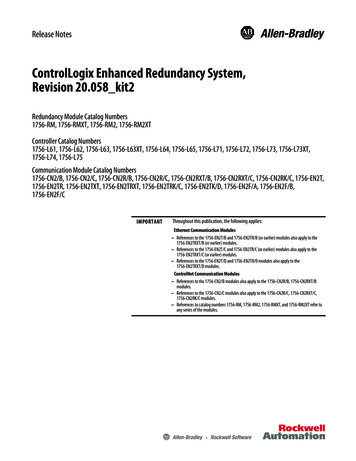![First Revision No. 3-NFPA 497-2014 [ Chapter 2 ]](/img/5/497-a2016-eec-aaa-fd-frstatments.jpg)
Transcription
National Fire Protection Association Report1 of etcher?commentPara.First Revision No. 3-NFPA 497-2014 [ Chapter 2 ]Chapter 2 Referenced Publications2.1 General.The documents or portions thereof listed in this chapter are referenced within this recommended practice and should beconsidered part of the recommendations of this document.2.2 NFPA Publications.National Fire Protection Association, 1 Batterymarch Park, Quincy, MA 02169-7471.NFPA 30, Flammable and Combustible Liquids Code, 2012 2015 edition.NFPA 33, Standard for Spray Application Using Flammable or Combustible Materials, 2011 2015 edition.NFPA 34, Standard for Dipping, Coating, and Printing Processes Using Flammable or Combustible Liquids, 2011 2015edition.NFPA 35, Standard for the Manufacture of Organic Coatings, 2011 2016 edition.NFPA 36, Standard for Solvent Extraction Plants, 2009 2013 edition.NFPA 45, Standard on Fire Protection for Laboratories Using Chemicals, 2011 2015 edition.NFPA 55, Compressed Gases and Cryogenic Fluids Code, 2010 2016 edition.NFPA 58, Liquefied Petroleum Gas Code, 2011 2017 edition.NFPA 59A, Standard for the Production, Storage, and Handling of Liquefied Natural Gas (LNG), 2009 2016 edition. NFPA 70 , National Electrical Code , 2011 2017 edition.2.3 Other Publications.2.3.1 ANSI Publications.American National Standards Institute, Inc., 25 West 43rd Street, 4th Floor, New York, NY 10036.ANSI/ISA-RP12.12.03, Recommended Practice for Portable Electronic Products Suitable for Use in Class I and II,Division 2, Class I, Zone 2 and Class III, Division 1 and 2 Hazardous (Classified) Locations , 2002.2.3.1 API Publications.American Petroleum Institute, 1220 L Street, NW, Washington, DC 20005-4070.API RP 500, Recommended Practice for Classification of Locations for Electrical Installations at Petroleum FacilitiesClassified as Class I, Division 1 and Division 2, 2002. (Reaffirmed, November 2002.) 3rd edition, 2008API RP 505, Recommended Practice for Classification of Locations for Electrical Installations at Petroleum FacilitiesClassified as Class I, Zone 0, Zone 1, and Zone 2, 2002, reaffirmed 2013 .2.3.2 ASHRAE Publications.American Society of Heating, Refrigeration and Air-Conditioning Engineers, Inc., 1791 Tullie Circle NE, Atlanta, GA30329-2305.ASHRAE 15, Safety Code Standard for Mechanical Refrigeration Systems , 2007 2013 .2.3.3 ASTM Publications.ASTM International, 100 Barr Harbor Drive, P.O. Box C700, West Conshohocken, PA 19428-2959.ASTM D323, Standard Method of Test for Vapor Pressure of Petroleum Products (Reid Method), 2008 (2014) .2.3.4 CGA Publications.Compressed Gas Association, 4221 Walney Road, 5th Floor 14501 George Carter Way, Suite 103 , Chantilly, VA20151-2923.ANSI/ CGA G2.1, Safety Requirements for the Storage and Handling of Anhydrous Ammonia, 1999.2.3.5 IEC Publications.International Electrotechnical Commission, 3, rue de Varembé, P.O. Box 131, CH-1211 Geneva 20, Switzerland.IEC TR3 60079-20, Electrical apparatus for explosive gas atmosphere—Part 20: Data for Flammable gaes andvapors, relating to the use of electrical apparatus , 1996 -1, Explosive atmospheres — Part 20-1: Materialcharacteristics for gas and vapor classification — Test methods and data , 2012 .11/26/2014 1:58 PM
National Fire Protection Association Report2 of etcher?commentPara.2.3.6 ISA Publications.The International Society of Automation, 67 T.W. Alexander Drive, P.O. Box 12277, Research Triangle Park, NC27709.ISA-RP12.12.03, Standard for Portable Electronic Products Suitable for Use in Class I and II, Division 2, Class IZone 2 and Class III, DIivision 1 and 2 Hazardous (Classified) Locations, 2011.2.3.7 Other Publications.Merriam-Webster’s Collegiate Dictionary, 11th edition, Merriam-Webster, Inc., Springfield, MA, 2003.2.4 References for Extracts in Recommendations Sections.NFPA 30, Flammable and Combustible Liquids Code, 2012 2015 edition.NFPA 59A, Standard for the Production, Storage, and Handling of Liquefied Natural Gas (LNG), 2009 2013 edition. NFPA 70 , National Electrical Code , 2011 2014 edition.Submitter Information VerificationSubmitter Full Name: [ Not Specified ]Organization:[ Not Specified ]Street Address:City:State:Zip:Submittal Date:Tue Sep 16 09:28:47 EDT 2014Committee StatementCommitteeStatement:Current editions referenced, updated titles of IEC and ISA standards, and eliminated the ANSI section due tostandard development by IEC. ASHRAE 34 is not referenced in NFPA 497.ResponseMessage:Public Input No. 5-NFPA 497-2014 [Section No. 2.3.3]Public Input No. 12-NFPA 497-2014 [Chapter 2]Public Input No. 20-NFPA 497-2014 [Section No. 2.3.4]11/26/2014 1:58 PM
National Fire Protection Association Report3 of etcher?commentPara.First Revision No. 19-NFPA 497-2014 [ Section No. 3.3.4 ]3.3.4 Combustible Liquid.Any liquid that has a closed-cup flash point at or above 100 F (37.8 C), as determined by the test procedures andapparatus set forth in Section 4.4 of NFPA 30, Flammable and Combustible Liquids Code . Combustible liquids areclassified according to Section 4.3 of NFPA 30 in accordance with the following: (1) Class II Liquid — Any liquid thathas a flash point at or above 100 F (37.8 C) and below 140 F (60 C); (2) Class III Liquid — Any liquid that has a flashpoint at or above 140 F (60 C); (a) Class IIIA Liquid — Any liquid that has a flash point at or above 140 F (60 C), butbelow 200 F (93 C); (b) Class IIIB Liquid — Any liquid that has a flash point at or above 200 F (93 C) . [30,2012 2015 ]3.3.4.1 Class II Liquid.Any liquid that has a flash point at or above 100 F (37.8 C) and below 140 F (60 C). [ 30: 4.3.2(1)]3.3.4.2 Class III Liquid.Any liquid that has a flash point at or above 140 F (60 C). [ 30: 4.3.2(2)]3.3.4.3 Class IIIA Liquid.Any liquid that has a flash point at or above 140 F (60 C), but below 200 F (93 C). [ 30: 4.3.2(2)(a)]3.3.4.4 Class IIIB Liquid.Any liquid that has a flash point at or above 200 F (93 C). [ 30: 4.3.2(2)(b)]Submitter Information VerificationSubmitter Full Name: Eric NetteOrganization:National Fire Protection AssocStreet Address:City:State:Zip:Submittal Date:Mon Oct 27 16:09:30 EDT 2014Committee StatementCommittee Statement: Definition revised to coincide with changes to NFPA 30.Response Message:11/26/2014 1:58 PM
National Fire Protection Association Report4 of etcher?commentPara.First Revision No. 20-NFPA 497-2014 [ Section No. 3.3.6 ]3.3.6 Flammable Liquid.Any liquid that has a closed-cup flash point below 100 F (37.8 C), as determined by the test procedures and apparatusset forth in Section 4.4 of NFPA 30, Flammable and Combustible Liquids Code , and a Reid vapor pressure that doesnot exceed an absolute pressure of 40 psi (276 kPa) at 100 F (37.8 C), as determined by ASTM D323, Standard TestMethod for Vapor Pressure of Petroleum Products (Reid Method). Flammable liquids are classified according toSection 4.3 of NFPA 30 as Class I liquids and further subclassified in accordance with the following: (1) Class IA Liquid— Any liquid that has a flash point below 73 F (22.8 C) and boiling point below 100 F (37.8 C); (2) Class IB Liquid —Any liquid that has a flash point below 73 F (22.8 C) and boiling point at or above 100 F (37.8 C); (3) Class IC Liquid— Any liquid that has a flash point at or above 73 F (22.8 C), but below 100 F (37.8 C) . [30,2012 2015 ]3.3.6.1 Class I Liquid.Flammable liquids, as defined in 3.3.33.2 and 4.2.3 of NFPA 30 , Flammable and Combustible Liquids Code , shallbe classified as Class I liquids and shall be further subclassified in accordance with Sections 3.3.6.2 through 3.3.6.4:[ 30, 2012]3.3.6.2 Class IA Liquid.Any liquid that has a flash point below 73 F (22.8 C) and a boiling point below 100 F (37.8 C) [ 30: 4.3.1(1)]3.3.6.3 Class IB Liquid.Any liquid that has a flash point below 73 F (22.8 C) and a boiling point at or above 100 F (37.8 C) [ 30: 4.3.1(2)]3.3.6.4 Class IC Liquid.Any liquid that has a flash point at or above 73 F (22.8 C), but below 100 F (37.8 C) [ 30: 4.3.1(3)]Submitter Information VerificationSubmitter Full Name: Eric NetteOrganization:National Fire Protection AssocStreet Address:City:State:Zip:Submittal Date:Mon Oct 27 16:10:45 EDT 2014Committee StatementCommittee Statement: Definition revised to coincide with changes to NFPA 30.Response Message:11/26/2014 1:58 PM
National Fire Protection Association Report5 of etcher?commentPara.First Revision No. 15-NFPA 497-2014 [ Section No. 4.1.2 ]4.1.2 *In a Class I hazardous (classified) location, the combustible material present is a flammable gas, flammable liquid–produced vapor, or combustible liquid–produced vapor mixed with air that could burn or explode .Submitter Information VerificationSubmitter Full Name: [ Not Specified ]Organization:[ Not Specified ]Street Address:City:State:Zip:Submittal Date:Fri Sep 19 11:03:54 EDT 2014Committee StatementCommitteeStatement:The current text if read literally conflicts with the stated conditions of the combustible material groups byaddressing only flammable gas or vapor. The revised text contains the complete description and agrees withthe material Group terms.ResponseMessage:Public Input No. 15-NFPA 497-2014 [Section No. 4.1.2]11/26/2014 1:58 PM
National Fire Protection Association Report6 of etcher?commentPara.First Revision No. 7-NFPA 497-2014 [ Sections 4.1.3, 4.1.4, 4.1.5, 4.1.6, 4.1.7 ]See FR-54.1.3Class I is further subdivided into either Class I, Division 1 or Class I, Division 2; or Class I, Zone 0, Zone 1, or Zone 2as detailed in 4.1.3.1 through 4.1.3.5 .4.1.3.1 Class I, Division 1.A Class I, Division 1 location is a locationIn which ignitible concentrations of flammable gases, flammable liquid–produced vapors, or combustible liquid–produced vapors can exist under normal operating conditions, orIn which ignitible concentrations of such flammable gases, flammable liquid–produced vapors, or combustibleliquids above their flash points may exist frequently because of repair or maintenance operations or because ofleakage, orIn which breakdown or faulty operation of equipment or processes might release ignitible concentrations offlammable gases, flammable liquid–produced vapors, or combustible liquid–produced vapors and might alsocause simultaneous failure of electrical equipment in such a way as to directly cause the electrical equipmentto become a source of ignition. [ 70: 500.5(B)(1)]4.1.3.2 Class I, Division 2.A Class I, Division 2 location is a locationIn which volatile flammable gases, flammable liquid–produced vapors, or combustible liquid–produced vaporsare handled, processed, or used, but in which the liquids, vapors, or gases will normally be confined withinclosed containers or closed systems from which they can escape only in case of accidental rupture orbreakdown of such containers or systems or in case of abnormal operation of equipment, orIn which ignitible concentrations of flammable gases, flammable liquid–produced vapors, or combustible liquid–produced vapors are normally prevented by positive mechanical ventilation and which might becomehazardous through failure or abnormal operation of the ventilating equipment, orThat is adjacent to a Class I, Division 1 location, and to which ignitible concentrations of flammable gases,flammable liquid–produced vapors, or combustible liquid–produced vapors above their flash points mightoccasionally be communicated unless such communication is prevented by adequate positive-pressureventilation from a source of clean air and effective safeguards against ventilation failure are provided.[ 70: 500.5(B)(2)]4.1.3.3 Class I, Zone 0.A Class I, Zone 0 location is a location in whichIgnitible concentrations of flammable gases or vapors are present continuously, orIgnitible concentrations of flammable gases or vapors are present for long periods of time. [ 70: 505.5(B)(1)]4.1.3.4 Class I, Zone 1.A Class I, Zone 1 location is a locationIn which ignitible concentrations of flammable gases or vapors are likely to exist under normal operatingconditions; orIn which ignitible concentrations of flammable gases or vapors may exist frequently because of repair ormaintenance operations or because of leakage; orIn which equipment is operated or processes are carried on, of such a nature that equipment breakdown orfaulty operations could result in the release of ignitible concentrations of flammable gases or vapors and alsocause simultaneous failure of electrical equipment in a mode to cause the electrical equipment to become asource of ignition; orThat is adjacent to a Class I, Zone 0 location from which ignitible concentrations of vapors could becommunicated, unless communication is prevented by adequate positive pressure ventilation from a source ofclean air and effective safeguards against ventilation failure are provided. [ 70: 505.5(B)(2)]11/26/2014 1:58 PM
National Fire Protection Association Report7 of etcher?commentPara.4.1.3.5 Class I, Zone 2.A Class I, Zone 2 location is a locationIn which ignitible concentrations of flammable gases or vapors are not likely to occur in normal operation and, ifthey do occur, will exist only for a short period; orIn which volatile flammable liquids, flammable gases, or flammable vapors are handled, processed, or used butin which the liquids, gases, or vapors normally are confined within closed containers of closed systems fromwhich they can escape only as a result of accidental rupture or breakdown of the containers or system, or as aresult of the abnormal operation of the equipment with which the liquids or gases are handled, processed, orused; orIn which ignitible concentrations of flammable gases or vapors normally are prev
First Revision No. 3-NFPA 497-2014 [ Chapter 2 ] Chapter 2 Referenced Publications 2.1 General. The documents or portions thereof listed in this chapter are referenced within this recommended practice and should be considered part of the recommendations of this document. 2.2 NFPA Publications. National Fire Protection Association, 1 Batterymarch Park, Quincy, MA 02169-7471. NFPA 30, Flammable .
![First Revision No. 147-NFPA 20-2013 [ Global Input ]](/img/4/20-a15-fim-aaa-fd-frstatements.jpg)
![First Revision No. 2-NFPA 33-2016 [ Section No. 1.3 ]](/img/4/33-f2017-faa-aaa-frreport.jpg)
